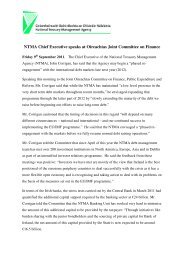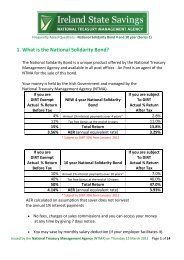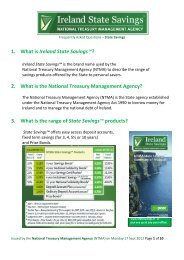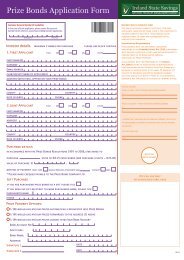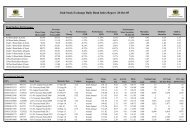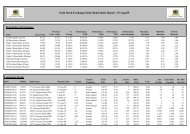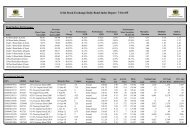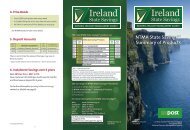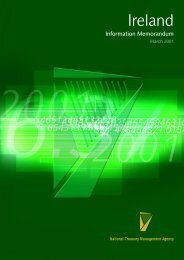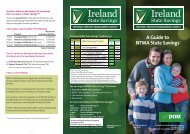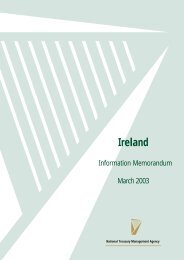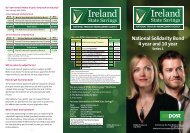Report & Financial Statements for the Year ended 31st December ...
Report & Financial Statements for the Year ended 31st December ...
Report & Financial Statements for the Year ended 31st December ...
Create successful ePaper yourself
Turn your PDF publications into a flip-book with our unique Google optimized e-Paper software.
SUMMARY OF ACTIVITY<br />
Summary of Activity<br />
The key features of 2004 were:<br />
Overall<br />
• The total asset and liability portfolios managed by<br />
<strong>the</strong> NTMA exceeded €50 billion <strong>for</strong> <strong>the</strong> first time.<br />
• Gross cashflows through <strong>the</strong> NTMA in 2004<br />
amounted to €532 billion.<br />
National Debt<br />
• The National Debt, when account is taken of <strong>the</strong><br />
National Pensions Reserve Fund and o<strong>the</strong>r funds<br />
managed by <strong>the</strong> NTMA, is now equivalent to around<br />
8 months’ tax revenue. When <strong>the</strong> NTMA was<br />
established in 1990, it took over three months’ tax<br />
revenue just to pay interest on <strong>the</strong> debt.<br />
• The General Government Debt/GDP ratio continued to<br />
fall – to 29.9 per cent at end 2004 (32.0 per cent at end<br />
2003) and continues to be one of <strong>the</strong> lowest in <strong>the</strong> EU.<br />
• Deducting <strong>the</strong> value of <strong>the</strong> National Pensions<br />
Reserve Fund would give an even lower ratio of<br />
around 21.5 per cent at end 2004.<br />
• The National Debt at end 2004 was €37.8 billion.<br />
• Interest payments on <strong>the</strong> Debt were €1,676 million.<br />
After adjusting <strong>for</strong> <strong>the</strong> impact of <strong>the</strong> Small Savings<br />
Reserve Fund, <strong>the</strong> cost to <strong>the</strong> Exchequer was €348<br />
million below budget. This was down to 4 per cent<br />
of tax revenue, about a fifth of <strong>the</strong> figure 10 years<br />
ago when <strong>the</strong> interest bill was 20 per cent of tax<br />
revenue. This reduction in <strong>the</strong> interest burden has<br />
freed up substantial resources <strong>for</strong> o<strong>the</strong>r purposes.<br />
• To meet debt repayments and <strong>the</strong> expected budget deficit,<br />
€3.4 billion was raised during 2004, at an average yield<br />
of 4.67 per cent, through five bond auctions. The bond<br />
auctions were cancelled in <strong>the</strong> second half of <strong>the</strong> year<br />
because of <strong>the</strong> emerging strength of <strong>the</strong> budgetary position.<br />
• To take advantage of low long term interest rates, a<br />
new benchmark bond, <strong>the</strong> 4 1 ⁄ 2% Treasury Bond 2020,<br />
was launched in January and investors in <strong>the</strong> 5%<br />
Treasury Bond 2013 were offered terms <strong>for</strong> switching<br />
€2 billion of <strong>the</strong>ir holdings into <strong>the</strong> new longer issue.<br />
• Over 79 per cent of Irish Government bonds are<br />
currently held by <strong>for</strong>eign investors, up from 73 per<br />
cent a year ago and sharply up from 22 per cent at<br />
end 1998, just be<strong>for</strong>e <strong>the</strong> introduction of <strong>the</strong> euro.<br />
As in recent years, virtually all of <strong>the</strong> debt issued in<br />
2004 was taken up by <strong>for</strong>eign investors.<br />
• In February 2005, <strong>the</strong> NTMA issued US$ 500<br />
million bonds under its Euro Medium Term Note<br />
Programme. These bonds have a coupon of 3.875<br />
per cent and mature in July 2010. They were<br />
issued at 10 basis points over US Treasuries and<br />
<strong>the</strong> proceeds were swapped into euro at 29.3 basis<br />
points below Euribor. This represents a saving of<br />
€3.5 million when compared with <strong>the</strong> cost of raising<br />
funds in <strong>the</strong> normal bond auctions.<br />
• HSBC-CCF became a Primary Dealer in Irish<br />
Government bonds in October 2004 and Royal<br />
Bank of Scotland in May 2005. This development<br />
reflects <strong>the</strong> continued increase in demand <strong>for</strong> Irish<br />
Government bonds by <strong>for</strong>eign investors. There are<br />
currently nine Primary Dealers, seven of whom are<br />
major international banks based overseas.<br />
• Ireland can now raise money in <strong>the</strong> euro area<br />
bond market at virtually <strong>the</strong> same cost as Germany<br />
and France, who are viewed as <strong>the</strong> benchmark<br />
borrowers. This is due to <strong>the</strong> continued strength of<br />
Ireland’s public finances, especially when compared<br />
with some of <strong>the</strong> major European countries, and <strong>the</strong><br />
internationalisation of <strong>the</strong> Irish Government bond<br />
market following <strong>the</strong> introduction of <strong>the</strong> euro. The<br />
NTMA’s policy of having a state-of-<strong>the</strong>-art sale and<br />
distribution system through <strong>the</strong> use of Bloomberg<br />
and Euroclear as well as <strong>the</strong> Primary Dealership<br />
system has facilitated this process.<br />
• Bond yields End 2004 17 June<br />
2005<br />
3 1 ⁄ 4% Treasury Bond 2009 2.95% 2.50%<br />
5% Treasury Bond 2013 3.50% 3.07%<br />
4.6% Treasury Bond 2016 3.75% 3.31%<br />
4 1 ⁄ 2% Treasury Bond 2020 3.99% 3.55%<br />
<strong>Report</strong> and Accounts <strong>for</strong> <strong>the</strong> year <strong>ended</strong> 31 <strong>December</strong> 2004<br />
9



